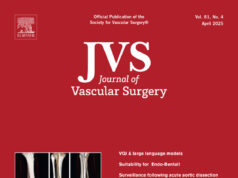
Hypercoagulability in COVID-19 patients leads to an increase in the malfunction rate of temporary hemodialysis catheters—but heparin locking of the catheters is linked to decreased malfunction rates.
Those are among the main findings of a study recently published in the Journal of Vascular Surgery.
The research sought to address the subset of COVID-19 patients with acute kidney injury who require hemodialysis. With temporary catheters being the mainstay in their treatment and up to 96% of COVID-19 patients experiencing dialysis circuit clotting, the investigators identified a “paucity” of data and guidelines to address the problem.
John J. Kanitra, MD, a general surgery resident in the department of surgery at Ascension St. John Hospital in Detroit, and colleagues carried out a retrospective cohort study via chart review at their institution—a large urban hospital. The study included patients who needed a temporary catheter placed between Feb. 1 to April 30, with follow-up for outcomes continued between May 1 and May 12.
A total of 48 patients with a mortality rate of 71% were identified. Malfunction occurred in 31.3% of patients. Thirty-seven patients (77.1%) received heparin locking, 22 (45.8%) received systemic anticoagulation and 38 (79.1%) received venous thromboembolism prophylaxis. The overall rate of malfunction was lower at a trend level of significance with heparin vs. saline locking (24.3% vs. 54.6%; p=0.058), Kanitra at al found.
Meanwhile, systemic anticoagulation did not affect temporary catheter malfunction rate (p=0.240). Higher D-dimer levels were related to greater mortality (HR 3.28, 95% CI 1.16–9.28; p=0.025), but were not significantly associated with temporary catheter malfunction (HR 1.79, 95% CI 0.42–7.71; p=0.434).
“The high malfunction rate is likely a result of the hypercoagulability that has been suggested in COVID-19 patients,” the authors write. “Reports describe COVID-19 patients without predisposing factors developing thromboembolic events. The etiology of this is thought to be endothelial damage driven by the cytokine storm, leading to excess thrombin formation in addition to increased blood viscosity from hypoxemia.”
The authors noted the need for prospective, randomized studies in order to confirm their findings—chiefly so that locking the temporary catheters with heparin in COVID-19 patients can be recommended. “Increased [venous thromboembolism] prophylaxis suggested a possible association with improved [temporary hemodialysis catheter] patency, though the comparison lacked sufficient statistical power,” they write. “Additionally, the current study found an 71% mortality rate in COVID-19 patients requiring acute HD, which has important implications for planning and resource delegation for future coronaviral infections.”
SOURCE: doi.org/10.1016/j.jvs.2020.11.033












